The Intel Xeon W-3175X Review: 28 Unlocked Cores, $2999
by Ian Cutress on January 30, 2019 9:00 AM ESTCPU Performance: Web and Legacy Tests
While more the focus of low-end and small form factor systems, web-based benchmarks are notoriously difficult to standardize. Modern web browsers are frequently updated, with no recourse to disable those updates, and as such there is difficulty in keeping a common platform. The fast paced nature of browser development means that version numbers (and performance) can change from week to week. Despite this, web tests are often a good measure of user experience: a lot of what most office work is today revolves around web applications, particularly email and office apps, but also interfaces and development environments. Our web tests include some of the industry standard tests, as well as a few popular but older tests.
We have also included our legacy benchmarks in this section, representing a stack of older code for popular benchmarks.
All of our benchmark results can also be found in our benchmark engine, Bench.
For our graphs, some of them have two values: a regular value in orange, and one in red called 'Intel Spec'. ASUS offers the option to 'open up' the power and current limits of the chip, so the CPU is still running at the same frequency but is not throttled. Despite Intel saying that they recommend 'Intel Spec', the system they sent to us to test was actually set up with the power limits opened up, and the results they provided for us to compare to internally also correlated with that setting. As a result, we're providing both sets results for our CPU tests.
WebXPRT 3: Modern Real-World Web Tasks, including AI
The company behind the XPRT test suites, Principled Technologies, has recently released the latest web-test, and rather than attach a year to the name have just called it ‘3’. This latest test (as we started the suite) has built upon and developed the ethos of previous tests: user interaction, office compute, graph generation, list sorting, HTML5, image manipulation, and even goes as far as some AI testing.
For our benchmark, we run the standard test which goes through the benchmark list seven times and provides a final result. We run this standard test four times, and take an average.
Users can access the WebXPRT test at http://principledtechnologies.com/benchmarkxprt/webxprt/
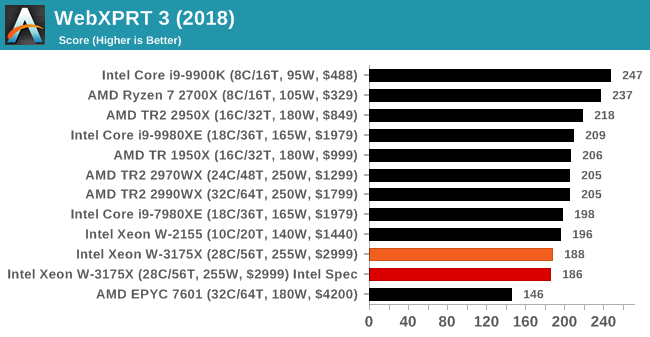
WebXPRT 2015: HTML5 and Javascript Web UX Testing
The older version of WebXPRT is the 2015 edition, which focuses on a slightly different set of web technologies and frameworks that are in use today. This is still a relevant test, especially for users interacting with not-the-latest web applications in the market, of which there are a lot. Web framework development is often very quick but with high turnover, meaning that frameworks are quickly developed, built-upon, used, and then developers move on to the next, and adjusting an application to a new framework is a difficult arduous task, especially with rapid development cycles. This leaves a lot of applications as ‘fixed-in-time’, and relevant to user experience for many years.
Similar to WebXPRT3, the main benchmark is a sectional run repeated seven times, with a final score. We repeat the whole thing four times, and average those final scores.
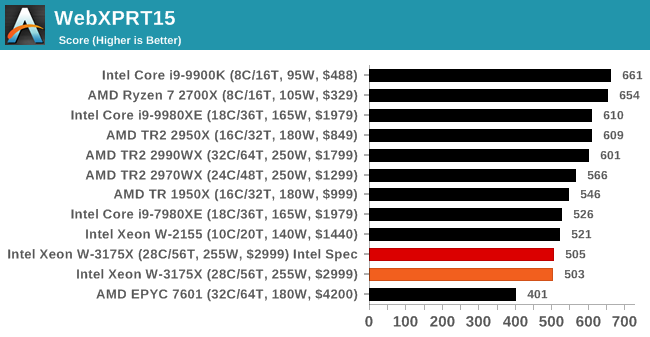
Speedometer 2: JavaScript Frameworks
Our newest web test is Speedometer 2, which is a accrued test over a series of javascript frameworks to do three simple things: built a list, enable each item in the list, and remove the list. All the frameworks implement the same visual cues, but obviously apply them from different coding angles.
Our test goes through the list of frameworks, and produces a final score indicative of ‘rpm’, one of the benchmarks internal metrics. We report this final score.

Google Octane 2.0: Core Web Compute
A popular web test for several years, but now no longer being updated, is Octane, developed by Google. Version 2.0 of the test performs the best part of two-dozen compute related tasks, such as regular expressions, cryptography, ray tracing, emulation, and Navier-Stokes physics calculations.
The test gives each sub-test a score and produces a geometric mean of the set as a final result. We run the full benchmark four times, and average the final results.
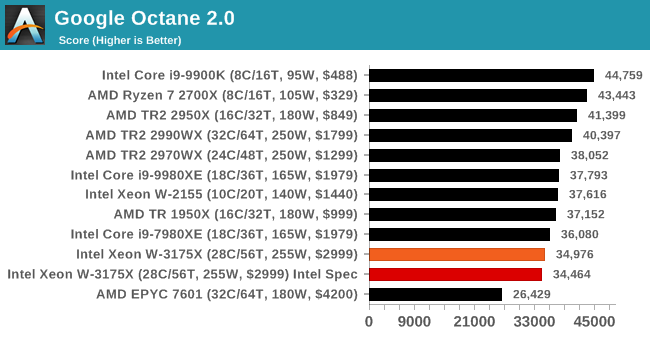
Mozilla Kraken 1.1: Core Web Compute
Even older than Octane is Kraken, this time developed by Mozilla. This is an older test that does similar computational mechanics, such as audio processing or image filtering. Kraken seems to produce a highly variable result depending on the browser version, as it is a test that is keenly optimized for.
The main benchmark runs through each of the sub-tests ten times and produces an average time to completion for each loop, given in milliseconds. We run the full benchmark four times and take an average of the time taken.
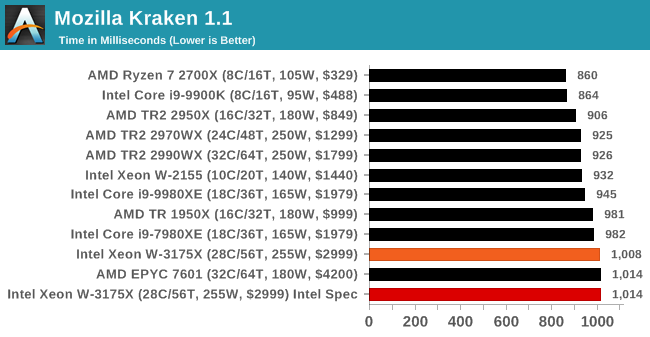
3DPM v1: Naïve Code Variant of 3DPM v2.1
The first legacy test in the suite is the first version of our 3DPM benchmark. This is the ultimate naïve version of the code, as if it was written by scientist with no knowledge of how computer hardware, compilers, or optimization works (which in fact, it was at the start). This represents a large body of scientific simulation out in the wild, where getting the answer is more important than it being fast (getting a result in 4 days is acceptable if it’s correct, rather than sending someone away for a year to learn to code and getting the result in 5 minutes).
In this version, the only real optimization was in the compiler flags (-O2, -fp:fast), compiling it in release mode, and enabling OpenMP in the main compute loops. The loops were not configured for function size, and one of the key slowdowns is false sharing in the cache. It also has long dependency chains based on the random number generation, which leads to relatively poor performance on specific compute microarchitectures.
3DPM v1 can be downloaded with our 3DPM v2 code here: 3DPMv2.1.rar (13.0 MB)

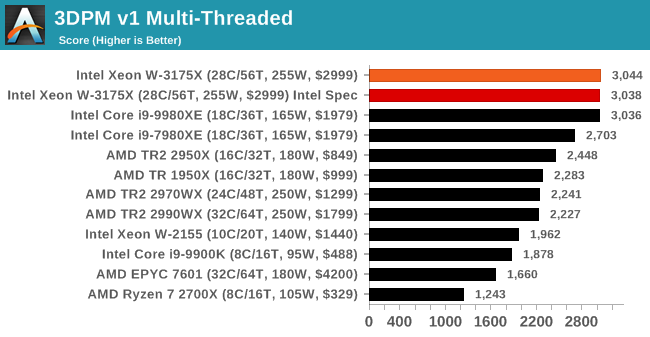
x264 HD 3.0: Older Transcode Test
This transcoding test is super old, and was used by Anand back in the day of Pentium 4 and Athlon II processors. Here a standardized 720p video is transcoded with a two-pass conversion, with the benchmark showing the frames-per-second of each pass. This benchmark is single-threaded, and between some micro-architectures we seem to actually hit an instructions-per-clock wall.

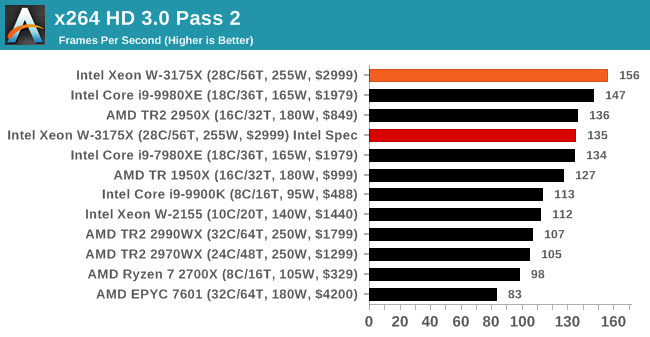










136 Comments
View All Comments
Kevin G - Wednesday, January 30, 2019 - link
For $3000 USD, a 28 core unlocked Xeon chip isn't terribly bad. The real issue is its incredibly low volume nature and that in effect only two motherboards are going to be supporting it. LGA 3647 is a wide spread platform but the high 255W TDP keeps it isolated.Oddly I think Intel would have had better success if they also simultaneously launched an unlocked 18 core part with even higher base/turbo clocks. This would have threaded the needle better in terms of per thread performance and overall throughput. The six channel memory configuration would have assisted in performance to distinguish itself from the highend Core i9 Extreme chips.
The other aspect is that there is no clear upgrade path from the current chips: pretty much one chip to board ratio for the life time of the product. There is a lot on the Xeon side Intel has planned like on package FGPAs, Omnipath fabric and Nervana accelerators which could stretch their wings with a 255 W TDP. The Xeon Gold 6138P is an example of this as it comes with an Arria 10 FPGA inside but a slightly reduced clock 6138 die as well at a 195 W TDP. At 255 W, that chip wouldn't have needed to compromise the CPU side. For the niche market Intel is targeting, a FPGA solution would be interesting if they pushed ideas like OpenCL and DirectCompute to run on the FPGA alongside the CPU. Doing something really bold like accelerating PhysX on the FPGA would have been an interesting demo of what that technology could do. Or leverage the FGPA for DSP audio effects in a full 3D environment. That'd give something for these users to look forward to.
Well there is the opportunity to put in other LGA 3647 parts into these boards but starting off with a 28 core unlocked chip means that other offering are a downgrade. With luck, Ice Lake-SP would be an upgrade but Intel hasn't committed to it on LGA 3647.
Ultimately this looks like AMD's old 4x4/QuadFX efforts that'll be quickly forgotten by history.
Speaking of AMD, Intel missing the launch window by a few months places it closer to the eminent launch of new Threader designs leveraging Zen 2 and AMD's chiplet strategy. I wouldn't expect AMD to go beyond 32 cores for Threadripper but the common IO die should improve performance overall on top of the Zen 2 improvements. Intel has some serious competition coming.
twtech - Wednesday, January 30, 2019 - link
Nobody really upgrades workstation CPUs, but it sounds like getting a replacement in the event of failure.could be difficult if the stock will be so limited.If Dell and HP started offering this chip in their workstation lineup - which I don't expect to happen given the low-volume CPU production and needing a custom motherboard - then I think it would have been a popular product.
DanNeely - Wednesday, January 30, 2019 - link
Providing the replacement part (and thus holding back enough stock to do so) is on Dell/HP/etc via the support contract. By the time it runs out in a few years the people who buy this sort of prebuilt system will be upgrading to something newer and much faster anyway.MattZN - Wednesday, January 30, 2019 - link
I have to disagree re: upgrades. Intel has kinda programmed consumers into believing that they have to buy a whole new machine whenever they upgrade. In the old old days we actually did have to upgrade in order to get better monitor resolutions because the busses kept changing.But in modern times that just isn't the case any more. For Intel, it turned into an excuse to get people to pay more money. We saw it in spades with offerings last year where Intel forced people into a new socket for no reason (a number of people were actually able to get the cpu to work in the old socket with some minor hackery). I don't recall the particular CPU but it was all over the review channels.
This has NOT been the case for Intel's commercial offerings. The Xeons traditionally have had a whole range of socket-compatible upgrade options. It's Intel's shtick 'Scaleable Xeon CPUs' for the commercial space. I've upgraded several 2S Intel Xeon systems by buying CPUs on E-Bay... its an easy way to double performance on the cheap and businesses will definitely do it if they care about their cash burn.
AMD has thrown cold water on this revenue source on the consumer side. I think consumers are finally realizing just how much money Intel has been squeezing out of them over the last decade and are kinda getting tired of it. People are happily buying new AMD CPUs to upgrade their existing rigs.
I expect that Intel will have to follow suit. Intel traditionally wanted consumers to buy whole new computers but now that CPUs offer only incremental upgrades over prior models consumers have instead just been sticking with their old box across several CPU cycles before buying a new one. If Intel wants to sell more CPUs in this new reality, they will have to offer upgradability just like AMD is. I have already upgraded two of my AM4 boxes twice just by buying a new CPU and I will probably do so again when Zen 2 comes out. If I had had to replace the entire machine it would be a non-starter. But since I only need to do a BIOS update and buy a new CPU... I'll happily pay AMD for the CPU.
Intel's W-3175X is supposed to compete against threadripper, but while it supposedly supports ECC I do not personally believe that the socket has any longevity and that it is a complete waste of money and time to buy into it verses buying into threadripper's far more stable socket and far saner thermals. Intel took a Xeon design that is meant to run closer to the maximally efficient performance/power point on the curve and tried to turn it into a pro-sumer or small-business competitor to the threadripper by removing OC limits and running it hot, on an unstable socket. No thanks.
-Matt
Kevin G - Thursday, January 31, 2019 - link
I would disagree with this. Workstations around here are being retrofitted with old server hand-me-downs from the data center as that requipment is quietly retired. Old workstations make surprisingly good developer boxes, especially considering that the costs is just moving parts from one side of the company to the other.Though you do have point that the major OEMs themselves are not offering upgrades.
drexnx - Wednesday, January 30, 2019 - link
wow, I thought (and I think many people did) that this was just a vanity product, limited release, ~$10k price, totally a "just because we're chipzilla and we can" type of thinglooks like they're somewhat serious with that $3k price
MattZN - Wednesday, January 30, 2019 - link
The word 'nonsensical' comes to mind. But setting aside the absurdity of pumping 500W into a socket and trying to pass it off as a usable workstation for anyone, I have to ask Anandtech ... did you run with the scheduler fixes necessary to get reasonable results out of the 2990WX in the comparisons? Because it kinda looks like you didn't.The Windows scheduler is pretty seriously broken when it comes to both the TR and EPYCs and I don't think Microsoft has pushed fixes for it yet. That's probably what is responsible for some of the weird results. In fact, your own article referenced Wendel's work here:
https://www.anandtech.com/show/13853/amd-comments-...
That said, of course I would still expect this insane monster of Intel's to put up better results. It's just that... it is impractical and hazardous to actually configure a machine this way and expect it to have any sort of reasonable service life.
And why would Anandtech run any game benchmarks at all? This is a 28-core Xeon... actually, it's two 14-core Xeons haphazardly pasted together (but that's another discussion). Nobody in their right mind is going to waste it by playing games that would run just as well on a 6-core cpu.
I don't actually think Intel has any intention of actually selling very many of these things. This sort of configuration is impractical with 14nm and nobody in their right mind would buy it with AMD coming out with 10nm high performance parts in 5 months (and Intel probably a bit later this year). Intel has no business putting a $3000 price tag on this monster.
-Matt
eddman - Thursday, January 31, 2019 - link
"it's two 14-core Xeons haphazardly pasted together"Where did you get that info? Last time I checked each xeon scalable chip, be it LCC, HCC or XCC, is a monolithic die. There is no pasting together.
eddman - Thursday, January 31, 2019 - link
Didn't you read the article? It's right there: "Now, with the W-3175X, Intel is bringing that XCC design into the hands of enthusiasts and prosumers."Also, der8auer delidded it and confirmed it's an XCC die. https://youtu.be/aD9B-uu8At8?t=624
mr_tawan - Wednesday, January 30, 2019 - link
I'm surprised you put the Duron 900 on the image. That makes me expecting the test result from that CPU too!!